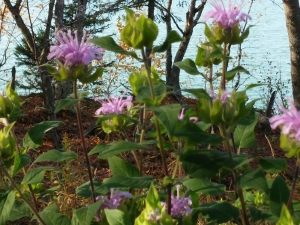“Every person on earth bears responsibility for good earth stewardship” Pope Francis

Northern Pearly Eye
How did we ever get sold on the fact that a green monoculture of a turf lawn was a good thing everyone wanted to copy? I love walking in green spaces, but should a green space have more variety than being just like everyone else trying to be like everyone else. Has our climate crisis brough us to a time we question the feasibility of maintaining something that harms instead of adding a positive to our environment?
What is my problem with a turf grass lawn?
First it takes lots of water to keep it green and needs poisonous chemicals. We have been in a drought, and homeowners are watering the sidewalk and the street trying to keep their lawns green. A weed free lawn requires lots of chemicals which run down the street into the storm drains and then into our lakes and streams where they stimulate the growth of algae. See the evidence on ponds and lakes covered with algae muck which can be fatal to dogs and wildlife. Muck covered lakes is not a natural happening!
A monoculture turf grass lawn has no benefit to pollinators. Pollinators love flowers free of chemicals and plants that are native to the area. They also like color and fragrance. The best is native plants have deep roots and can survive without much water.

Deep rooted native plants
You can create a friendly yard by just not mowing it, but I recommend thinking about a happy bee lawn. Bee lawns composed of various low growing plants don’t require chemicals and are not toxic to humans and pets. Also children can run and play on them just like turf grass. The butterflies and bees love diversity, scent and color. Some of my favorites are native violets and barren wild strawberries, both are very easy to grow and can be mowed a few times a summer. See the link below on bee lawns. Some people like non-native clover and creeping Charlie.

Violets are great for bee lawns.
Start with a small section of your yard, mow it short and work in some seeds (violets, strawberry, clover, creeping thyme, heal all) with a rake or hoe, and keep moist until you get some new sprouts. Find seeds at https://www.prairiemoon.com/
Nature’s Best Hope: https://www.bing.com/videos/search?q=doug+tallamy+videos&view=detail&mid=AB8B87BD969B5366B02BAB8B87BD969B5366B02B&FORM=VIRE by Doug Tallamy
How to save the planet starting with your yard: https://slate.com/podcasts/how-to/2022/08/how-to-save-the-planet-with-native-plants?fbclid=IwAR37nC8uiu9P6EoaXAF1Edm16g3zjKTCdx8zm1vH1JaZQdw0G9kQBqUgvK0
Mowing lawns as the climate warms (startribune.com)
Endangered migrants come in all shapes and species (startribune.com)
https://www.pennlive.com/life/2022/08/bee-lawns-a-lazy-mower-way-to-help-pollinators.html
Everyday appreciating our beautiful earth, and working for healthy communities through less chemicals, less waste, And more fun!































